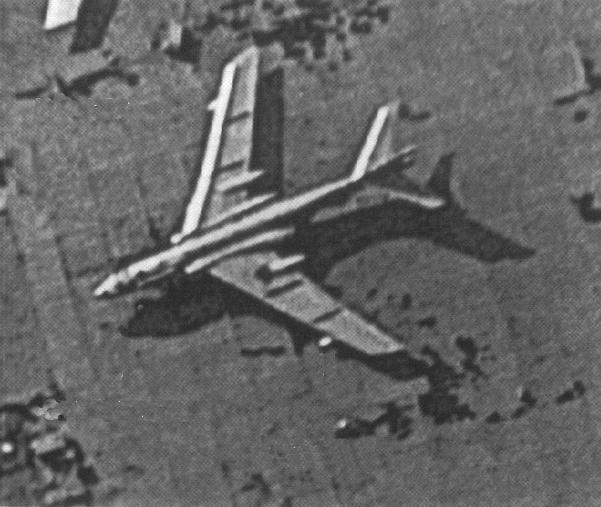


KH-12 IMPROVED CRYSTAL Product

Beijing creates military monster
By Bill Gertz
THE WASHINGTON TIMES
"Subjugating the enemy's army without fighting is the true pinnacle of excellence. Thus, the highest realization of warfare is to attack the enemy's plans."
-- "The Art of War," Sun Tzu
China has embarked on a major buildup of state-of-the-art military might, including its first aircraft carriers, designed to give the People's Liberation Army capabilities for defeating U.S. forces and threatening U.S. interests in Asia, according to American intelligence officials and China analysts.
. . . . Understanding that buildup and divining the long-term military ambitions of China's secretive leaders are enough to turn even America's top war fighter in the region into a diplomat.
. . . . "Our overall strategy is to deal with China from a position of strength," says Adm. Joseph W. Prueher, commander of the U.S. Pacific Command, the military force responsible for fighting any wars in Asia.
"But we also are focusing on what China's interests are and respecting those interests."
. . . . China's strategic intentions "are part of every discussion we have with every nation in the theater," the admiral says.
. . . . Other analysts see China as an emerging superpower and the pre-eminent challenge to U.S. interests in Asia.
. . . . Arthur Waldron, a China specialist at the U.S. Naval War College, sees China's conventional weapons development -- aimed at projecting power far beyond its current limits -- as a concern, exacerbated by signs of "aggressive intent" over Taiwan and the Spratly Islands in the South China Sea. China, Taiwan and four other countries in the region claim all or part of the Spratlys.
. . . . China is making claims to national boundaries that extend 1,000 miles beyond those recognized by most of its neighbors and reach as far south as the southern rim of the South China Sea.
. . . . "It's illusory to think they can achieve that by military force, but it's a goal, and they are attempting to structure their forces with that as a target," Mr. Waldron says. "That is something that must cause us concern."
. . . . "The kinds of things the Chinese are doing to enhance their military capability are both offensive in nature, in the sense they involve power projection, and also out of proportion to any threat," says Sen. Jon Kyl, Arizona Republican and member of the Senate Intelligence Committee. "That's the concern the policy-makers have."
. . . . U.S. uncertainty about China's ultimate military aims was starkly illustrated this week with the release of a Pentagon analysis of China's defense modernization.
. . . . "Chinese statements and actions support the theory that China will continue to emphasize economic growth and economic modernization, rather than military might, as a foundation for national greatness," the analysis says.
. . . . But the next sentence warns, "As an emerging great power, China will probably build its military power to the point where it can engage and defeat any potential enemy within the region with its conventional forces and can deter any global strategic threat to China's national security."
. . . . Rep. Floyd D. Spence, South Carolina Republican and chairman of the House National Security Committee, says the hedged language cannot mask real fears about China's ultimate aims.
. . . . "Chinese leaders have said we are the enemy and stand as the major roadblock checking their desire to dominate East Asia," Mr. Spence says. "This report, though couched in careful bureaucratic language, admits as much."
. . . . The level of U.S. forces in Asia, including 100,000 troops and the 7th Fleet, is under review as part of the Pentagon's four-year examination of force structure and strategy.
. . . . But while the Defense Department weighs cuts in its regional forces, China is engaged in an across-the-board effort to buy and develop arms aimed directly at challenging U.S. military power and capabilities.
. . . . According to the officials and analysts, the Chinese defense effort includes:
- Building several aircraft carriers in the next 15 years. "In the 2010 timeframe, China is projected to field its first aircraft carrier," according to a February report by the U.S. Office of Naval Intelligence.
- Replacing older warships with new ships outfitted with advanced anti-ship missiles, surface-to-air missiles and anti-submarine capabilities.
- Developing six new fighter aircraft and purchasing 48 Russian Su-27 fighters.
- Designing a new class of nuclear attack submarines and a new class of nuclear ballistic missile submarines.
- Building land-based and mobile intercontinental ballistic missiles with multiple warheads.
. . . . The effort comes at a time of rising nationalism and growing anti-American sentiment in China. Analysts say those feelings are partly the product of efforts by China's rulers to restore the army's tarnished image after its role in the 1989 massacre of democracy demonstrators in Beijing's Tiananmen Square.
. . . . U.S. defense and intelligence officials now regard China as a "near peer" military competitor, although not all analysts conclude that China poses a direct military threat.
. . . . Adm. Prueher says China is not now a threat but could become one through its weapons development and military modernization.
. . . . "We do not see them as a threat," he says. "In my estimation, China is about a decade and a half away with its training and equipment before they can put it all together."
. . . . "We aren't trying to portray China as an enemy," a senior military intelligence official says.
. . . . But "the trend that we see in China arming itself with strategic capability is not as positive" as current relations, the official said.
. . . . The most recent -- and in many ways, the most ominous -- U.S.-China clash erupted in March 1996 over Taiwan.
. . . . Chinese forces carried out several days of menacing war games and imposed a virtual blockade of Taiwan with a series of four short-range-missile tests bracketing the island. The exercises, just before Taiwan's presidential elections, prompted a major show of U.S. force: the deployment of two aircraft carrier battle groups near the island.
. . . . The United States, while recognizing "one China" in the Taiwan dispute, has pledged to prevent reunification by force and likely would be drawn into a war if China tried to seize Taiwan.
. . . . Adm. Prueher says China's efforts to intimidate Taiwan have met with unified resistance from the United States and many nations in the region.
. . . . The dispute between Taiwan and the mainland could become a "tinderbox" if those involved don't remain committed to resolving their differences peacefully, the four-star admiral says.
. . . . "We and the other nations are very much committed to freedom of navigation in the South China Sea and the sovereignty issue of the Spratlys and Paracels," he says.
. . . . Other officials and analysts say Chinese statements of benign intentions cannot mask a provocative buying spree in military hardware. China's new weapons programs, they say, are a means to project power and include capabilities far beyond those needed for countering traditional regional rivals, including Japan, India, the Philippines, Indonesia and Vietnam.
. . . . The weapons being purchased and developed include systems designed for attacking U.S. ships and aircraft, including two Russian warships with SS-N-22 anti-ship cruise missiles, which Moscow developed to destroy U.S. Aegis-class ships.
. . . . Construction of a Chinese carrier has not begun, but U.S. naval intelligence officials say the multibillion-dollar program will be a major step forward for a sea-and-air-oriented strategy of projecting power up to 1,000 miles from China's east coast.
. . . . "They are trying to develop it. There's no doubt about that," a senior U.S. intelligence official says.
. . . . The collapse of the Soviet Union in 1991 allowed China's military planners to redeploy massive numbers of ground forces protecting the country's northern and western borders.
. . . . A Pentagon specialist on China says the Chinese army, with some 2.2 million troops, is not modernizing as rapidly as naval and air forces are. The ground forces are likely in the future to be called on to maintain civil order in western and northern regions rather than defend borders.
. . . . U.S. high-technology warfare in the 1991 Persian Gulf war, especially the use of precision-guided bombs, stealth aircraft and long-range cruise missiles, dealt a fatal blow to China's army-oriented "sea of people" warfare strategy, employed in wave attacks during the Korean War.
. . . . "The effectiveness of modern long-range land-attack cruise missiles convinced the Chinese leadership that the first line of China's maritime defense must be moved hundreds of miles out to sea," the Office of Naval Intelligence report says.
. . . . China has begun seeking high-quality advanced-technology weaponry and has focused its military strategy on projecting power along its 10,000 nautical miles of coastline as part of a "Two Island Chain" strategy.
. . . . The strategy calls for beefing up naval and air forces to project power from China's east coast to cover two sets of islands. One stretches south from Japan through Taiwan and all the way to Indonesia and Singapore. The other embraces a huge swath of the Pacific Ocean that includes all of Japan's islands, areas beyond the Mariana Islands and a line extending southward hundreds of miles west of the Philippines.
. . . . "The Chinese navy should exert effective control of the seas within the first island chain," says People's Liberation Army Gen. Liu Huaqing, head of the PLA navy. "'Offshore' should not be interpreted as coastal as we used to know it. Offshore is a concept relative to the high seas. It means the vast sea waters within the second island chain."
. . . . Ross H. Munro, co-author of a much-discussed new book with the ominous title "The Coming Conflict With China," says many U.S. intelligence and policy officials play down the Chinese military threat, comparing China's arsenal with superior U.S. counterparts.
. . . . "That is a very misleading way to look at rising Chinese military power," he says. "Even today, Chinese military power is much greater than that of Iraq, but Iraq was able to create very serious problems for us."
. . . . China's technology exports also have caused continuing friction between Beijing and Washington. When he was CIA director, John M. Deutch told a Senate hearing last year that China continues to sell inappropriate weapons technology.
. . . . A report last month by the Office of Naval Intelligence says China has been "actively marketing" anti-ship cruise missiles for two decades but stepped up sales in the past two years.
. . . . "Likely customers for Chinese [anti-ship cruise missiles] include Bangladesh, Egypt, Iran, Iraq, Pakistan, Thailand and perhaps Burma," the report says. "Proliferation is expected to continue and China will be a major player in the international arms market for the 21st century."
. . . . Michael Pillsbury, a senior Pentagon official in the Reagan and Bush administrations, says: "China's relentless secrecy is undermining the efforts of senior U.S. military and intelligence officials to dismiss the China arms buildup as purely defensive and an acceptable path for an emerging power."
A satellite photograph taken last year over central China shows one of five Chinese B-6D bombers that were converted into air-refueling tankers. The Defense Intelligence Agency says the tankers allow Beijing's planes to reach well into the South China Sea.

http://www.fas.org/irp/imint/kh12_2.htm
Created by John Pike
Maintained by Webmaster
Updated Thursday, April 10, 1997





